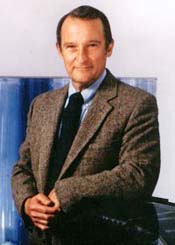| Seymour Cray  AKA Seymour Roger Cray, Jr. AKA Seymour Roger Cray, Jr.
Born: 28-Sep-1925
Birthplace: Chippewa Falls, WI
Died: 5-Oct-1996
Location of death: Colorado Springs, CO
Cause of death: Accident - Automobile
Remains: Cremated, scattered in the Colorado mountains
Gender: Male
Race or Ethnicity: White
Sexual orientation: Straight
Occupation: Inventor, Engineer, Business Nationality: United States
Executive summary: Inventor of Cray supercomputers Military service: US Army (1943-46) Frequently called the father of supercomputers, Seymour Cray designed and built the largest and speediest computers of his era. For more than thirty years from the early 1960s to the late 1990s, the fastest computer in the world was whatever machine Cray had most recently designed. Yet he sometimes joked that he was more a plumber than an engineer, because much of his computer design work consisted of crafting cooling systems to keep the hardware from overheating, and ensuring that the computer would neither boot nor operate if the cooling system malfunctioned.
He began his career at Engineering Research Associates in the 1950s, where he had a hand in designing the ERA 1103, an early scientific computer. When ERA was purchased by Remington Rand and later Sperry, Cray worked on the Universal Automatic Computer (UNIVAC), the first computer used for ordinary business applications.
He subsequently worked for Control Data Corporation, where he was the lead designer on the CDC 1604 in 1960, the first computer to use Germanium transistors instead of the valves or vacuum tubes used in earlier computers. Cray's next project was the CDC 6600 computer, the first commercial supercomputer, introduced in 1964, and the first computer to use silicon planar transistors. The 1604 had been the fastest computer in the world until it was superseded by the 6600, and Cray's CDC 7600, introduced in 1969, was about five times faster than the 6600.
He left Sperry Rand in 1972 to establish his own company, Cray Research (now simply Cray). At Cray Research he designed the first vector supercomputer, the Cray-1, introduced in 1976. It was the fastest computer available at the time, and sold over 100 units, far more than the dozen or so that had been anticipated. Weary of administrative tasks, Cray quit as CEO of his company in 1980, but continued working there, as a consulting designer.
The Cray X-MP was introduced in 1982, and proved another resounding success, but Cray himself was only minimally involved in its design, as he occupied himself instead with the Cray-2. Introduced in 1985, the Cray-2 could process a record-setting 1.2 billion calculations per second, but it had somewhat disappointing sales, constrained by its hefty price tag and competition from his own company's X-MP. When the Cray-3 project went over-budget it was spun off to a new company, Cray Computer Corporation. Only one Cray-3 was delivered, in 1993, and while Cray designed a Cray-4, it was never built. Cray Computer was liquidated in bankruptcy in 1995.
The following year he established another company, SRC Computers (named for his initials), intending to design a new massively parallel machine. His plans were cut short by an auto accident on 22 September 1996, which led to his death two weeks later. The company continued, however, delivering a product largely of Cray's design, and SRC remains an industry leader in reconfigurable computing.
In an interview a few years before his death, he said, "For the last 30 or 40 years I've been getting my insights from the customers who bought the Cray computers. They would tell me what's wrong with it. I'd address those issues and we'd go another generation. It's been very evolutionary. Essentially every machine I've designed since that first day have been clear descendants of one another in their structure."
Steve Jobs was one of Cray's customers, purchasing a Cray X-MP for design work while planning the next-generation Apple Macintosh in the mid 1980s. According to the company websites of both Cray and Macintosh, Cray himself said that he used a Mac to simulate the behavior of the Cray-3 during its design.
As a hobby, he constructed tunnels under the grounds of his home in Chippewa Falls, Wisconsin. Cray once explained that he worked on the underground passageways whenever he was baffled by a particularly stubborn design problem, and added, presumably in jest, that while digging, "elves will often come to me with solutions to my problem". Father: Seymour Cray (civil engineer)
Mother: Verene Cray (homemaker)
Sister: Carol Kersten (younger)
Wife: Verene (librarian, div. 1975, 3 children)
Wife: Geri M. Harrand (m. 1980)
Daughter: Susan Cray Borman
Daughter: Carolyn Cray Arnold
Son: Steven Cray (attorney)
High School: Chippewa Falls Senior High School, Chippewa Falls, WI (1943)
University: BS Electrical Engineering, University of Minnesota (1950)
University: MS Mathematics, University of Minnesota (1951)
SRC Computers Founder & President (1996-)
Cray Computer Corporation Founder & President (1989-95)
Cray Consultant (1980-89)
Cray Founder & CEO (1972-80)
Control Data Corporation Director of Engineering (1958-72)
Sperry Rand Director of Scientific Computing (1955-58)
Remington Rand Engineer (1952-55)
Unisys Engineer, Engineering Research Associates (1950-52)
IEEE
Tau Beta Pi Engineering Honor Society
Surgery 23-Sep-1996 (in the aftermath of an auto accident)
National Inventors Hall of Fame
Requires Flash 7+ and Javascript.
Do you know something we don't?
Submit a correction or make a comment about this profile
Copyright ©2019 Soylent Communications
|